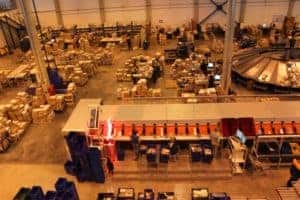
Adrien Henni, chief editor, East-West Digital News
Ozon Holdings, one of the most established Russian e-commerce companies, — sometimes dubbed, with some exaggeration, ‘the Russian Amazon,’ — will receive 3.5 billion rubles and possibly up to 5.25 billion ($61 million and up to $92 million at the current exchange rate) from its existing shareholders.
The better part of the capital injection will come from MTS, which invested in Ozon in 2014, and Baring Vostok, an early investor in the company.
A leading Russian mobile operator and an active investor in the digital field, MTS is committed to invest 1.15 billion rubles around ($20 million) in exchange for an additional stake in the company (13.7%, up from 11.2%). An optional capital injection of 582 billion rubles ($10 million) could further bring its share to 14.7%, according to MTS’s press release.
“Since [we invested in the company in] 2014, Ozon has seen exceptional revenue growth and improved operational performance. Now, however, is an opportune time to expand, and we believe that Ozon can use the additional resources to increase its reach and further improve its efficiency,” said Alexei Kornya, VP Finance, Investment, Mergers and Acquisitions at MTS.
“We boost our own e-commerce efforts and pursue our 3D strategy by expanding the digital services available to our clients,” he added, reminding the recent acquisition of two online ticketing services.
Giant capital injections
Ozon’s $150 million round of funding in 2014 came as the largest one in the history of Russian e-commerce — and has remained so to date, putting aside Sberbank’s $500 million investment last year in a joint venture with Yandex.
Three years earlier, in September 2011, Ozon had raised $100 million from a consortium comprising Russian funds and the Japanese e-commerce giant Rakuten.
The company was founded in 1998, with an initial focus on books, CDs and DVDs. The site enlarged its positioning in the mid-2000s – following the example of Amazon – with consumer electronics, cameras and mobile phones and later added children’s goods and travel products.
Ozon launched Ozon Travel in 2009; acquired Sapato.ru, a major online retailer of shoes and accessories, in 2012; and took control of Litres, the Russian e-book leader, two years later.
The company has also developed an in-house fulfillment and delivery network which encompasses several hundreds of cities in Russia with more than 2,500 pick-up points. A major part of Ozon’s successive fundings have gone to developing further these logistics capacities – and the capital injections announced today will be no exception.
Ozon now claims 3.2 million unique buyers.

Ozon has developed one of the largest e-commerce logistics networks across Russia. (Photo credit: Ozon).
According to EWDN’s Russian E-Commerce Report, online sales in 2016 exceeded $26 billion, growing more than 20% year-on-year. Included in this figure are some $16 billion for physical goods and $10 billion for online travel, according to Data Insight. The cross-border segment is the fastest growing, up 26% by value and 80% by the number of parcels and small packages, and exceeded $4 billion for physical goods alone, according to Russian Post and industry association NAMO. The 2017 numbers are not available yet.
This article first appeared in East-West Digital News, the international online resource on Russian digital industries, and is reprinted with permission.
